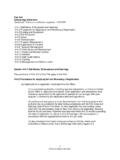Transcription of SCHOOL-AGE CARE ENVIRONMENT RATING …
1 SCHOOL-AGE care ENVIRONMENT RATING SCALE (SACERS). Statements of Developmentally Appropriate Practice for items included on the Tennessee Child care Evaluation Program SPACE AND FURNISHINGS. 1. Indoor space After being in school all day, school age children need aftercare space that is sufficient and ample for a variety of activities. The space should be clean, comfortable, and in good repair in order for children to feel good about being there. 2. Space for gross motor activities Children need daily opportunities, both in an outdoor and indoor space, to exercise large muscles, run in open spaces, and exercise gross motor skills. It is best practice to provide a variety of surfaces to allow for different types of activities that promote interaction as children participate in team and group games.
2 This is the best way to encourage older children to become involved in a group. 3. Space for privacy After being in the academic school setting, in which individuals are one of many, children need places where they can escape from the pressures of group situations. These areas should be accessible, protected from intrusion by others, and should be able to be easily monitored. Activities that are set up for one or two children help to promote positive self-esteem. 4. Room arrangement school age children feel valued and respected when space and materials are arranged and designed to allow for a wide variety of age appropriate activities that appeal to their interests.
3 Interest centers, in which topical and frequently requested materials are organized and accessible, promote independent use and active involvement. A quiet space set aside for homework communicates to children the value of establishing good study habits. 5. Furnishings for routine care (eating, nap, storage of children's possessions). Children need appropriate furnishings to meet the demands of their daily schedules. Basic furniture, such as tables and chairs, should be sturdy and appropriate to the size of the children in the group. This allows children to be comfortable, have proper body support, and be able to focus on learning, playing, Distributed by the UT College of Social Work Office of Research & Public Service.
4 May not be copied, shared, sold, or distributed in any manner. Unauthorized duplication is not permitted. Items and indicators reprinted from SCHOOL-AGE care ENVIRONMENT RATING Scale (SACERS), by Thelma Harms, Ellen Vineberg Jacobs, and Donna Romano White. (Teachers College Press, Copyright 1996 by Thelma Harms, Ellen Vineberg Jacobs, and Donna Romano White.) Used with the permission of the publisher and the authors. All rights reserved. ERS and ENVIRONMENT RATING Scale are registered trademarks of Teachers College, Columbia University. This project is funded under an agreement with the Tennessee Department of Human Services and the University of Tennessee College of Social Work Office of Research and Public Service.
5 Updated 8-1-16. and routine activities rather than their own discomfort. Children take responsibility for themselves when they can independently store their possessions. 6. Furnishings for learning and recreational activities Tables and chairs, along with other furnishings, should encourage a variety of learning and recreational activities. These furnishing should promote independent use by young learners. Self-esteem is promoted when a space is designated for display of children's work. 7. Furnishings for relaxation and comfort Children need space and opportunity to rest and relax. Soft furnishings allow children opportunities for relaxation and comfort.
6 Cozy areas that are clean and inviting send the message that alone time is needed and important for overall development. 8. Furnishings for gross motor activities Children need age appropriate, stationary and portable equipment to promote a wide variety of skills that exercise large muscles while developing confidence and abilities. Equipment should be sound, sturdy, safe, and accessible to children daily. Equipment designed to promote individual or group play and that is flexible helps to maintain children's interest. HEALTH AND SAFETY. 13. Health practices Children need a healthy ENVIRONMENT and the opportunity to learn about good nutrition and proper health practices.
7 Practicing preventive measures, such as washing hands after handling pets or wiping noses, help to educate children to achieve life-long health practices. Taking appropriate action when children are sick will minimize the spread of germs. 15. Safety practices Protecting children is critical in providing quality care , whether through adequate supervision or minimizing hazards both inside and outside. Caregivers should anticipate potential safety problems and demonstrate, model, and teach children safe practices. Emergency phone numbers, regularly practiced evacuation drills, and adequate first aid supplies also aid in protecting the children.
8 16. Attendance In order to guarantee safety of the children during the transition between school and aftercare and to adequately maintain the continuity between parents, school , and caregiver, recording attendance is a Distributed by the UT College of Social Work Office of Research & Public Service. May not be copied, shared, sold, or distributed in any manner. Unauthorized duplication is not permitted. Items and indicators reprinted from SCHOOL-AGE care ENVIRONMENT RATING Scale (SACERS), by Thelma Harms, Ellen Vineberg Jacobs, and Donna Romano White. (Teachers College Press, Copyright 1996 by Thelma Harms, Ellen Vineberg Jacobs, and Donna Romano White.)
9 Used with the permission of the publisher and the authors. All rights reserved. ERS and ENVIRONMENT RATING Scale are registered trademarks of Teachers College, Columbia University. This project is funded under an agreement with the Tennessee Department of Human Services and the University of Tennessee College of Social Work Office of Research and Public Service. Updated 8-1-16. necessary requirement of the caregiver. Adequate procedures for absentee notification either by the parents, the school , or the aftercare facility should be in place. 17. Departure A procedure that indicates an authorized adult has picked up a child is required. The adult should enter the facility and use a check out system.
10 In cases where children are bussed home, caregivers should escort children to and from the bus and discuss the importance of safe travel behavior with the children on a regular basis. 18. Meals/snacks Meals and snacks that follow USDA guidelines contribute to the health of children and provide a model for good nutritional habits for life-long practice. Proper hand washing along with careful food preparation teaches children proper hygiene and promotes sanitary conditions. Special dietary restrictions or allergies should be considered. 19. Personal hygiene Provisions, such as soap, paper towels, and tissues, are essential in maintaining proper hygiene that includes hand washing.





